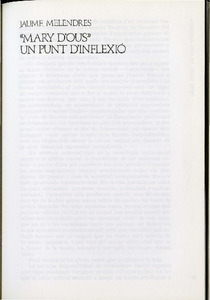Search
Now showing items 1-2 of 2
«Mary d’Ous», un punt d’inflexió
Article
Estudis escènics: quaderns de l'Institut del Teatre. 1983, Núm. 22
Open Access
<p>This work is a compilation of the results of a seminar made by the Department of Theatrical Sciences of the lnstitut del Teatre of Barcelona about the “Analysis of shows recorded in video”; it takes part in the effort, more and more widespread all over the world, to bestow on the theatrical criticism, as it is called nowadays, its own and true statute of independent and theoretical reflection.</p>
<p>We have chosen Mary d'Ous, a show by Els Joglars, because it is the topmost point of a theatrical conception based on the absence of a plot and also the last one of this kind of shows. In fact, after Mary d'Ous, Els Joglars changed completely. Alias Serrallonga, their following show, belongs no more to the same universe.</p>
<p>We believe that Mary d'Ous is the most current show of Els Joglars because it is the one which makes most clear the present needs of the dramatic criticism and which gives us more reasons and more images to try to overcome them.</p>
<p>We reproduce here a fragment of the text written by Els Joglars to hand it out: “Mary d'Ous: Variations on two themes. Show begum in Pruït (Barcelona) in June 1972 and finished in Barcelona at the beginning of December of the same year. The formal purpose of this show can be summarized as follows: it constitutes an attempt to obtain a maximum of scenic efficiency, using a minimum of elements related both to the plot and to the scenography. The show is based on a series of improvisations and studies made by the actors on the generic theme of the musical arrangement transposed to the dramatic process (canon, fugue, counterpoint, variations on themes, etc.).”</p>...
El quadern de direcció d’«Otel·lo», de William Shakespeare, espeblert per Konstantin Stanislavski
Article
Estudis escènics: quaderns de l'Institut del Teatre. 1983, Núm. 22
Open Access
<p>This article is a compilation of the conclusions of a seminar where the contents of the direction notebook which Stanislavsky wrote up in Nice in 1929 were analysed in order to direct the group Art's Theatre of Moscow in its play Othello by Shakespeare. After the issue of the notebook' s French edition (Mise en Scene d'Othello. Éditions du Seuil. Paris, 1973), the seminar tried to take out from it the most interesting aspects related to the theatre. Thanks to the accurate instructions given by the master to his group Art's Treatre, the seminar was able to dissect the essential and constant elements of Stanislavsky's work from the text by Shakespeare. The first part of that article, entitled “Directing actors is a dramatic art”, explains the formal keys of the notebook and analyses its dramatic deal, the criterion followed to omit certain parts of the original text, the scenographic conception and the way to deal with the characters. That analysis reveals Stanislavsky's way of adapting Shakespeare to his method of directing actors, which, in short, is equivalent to bringing tragedy to the drama's field. The second part, entitled “Advices given by the master”, emphasizes sorne fragments of the direction notebook of Othello, which can be considered excellent and practical lessons in the field of the self-control of the actor's energy in the performance.</p>...



